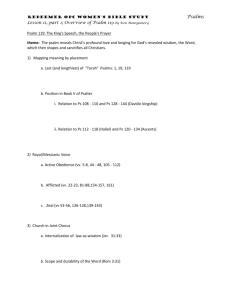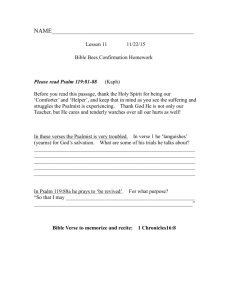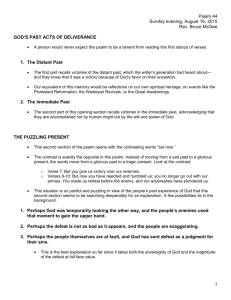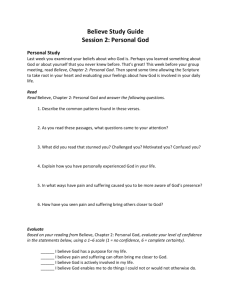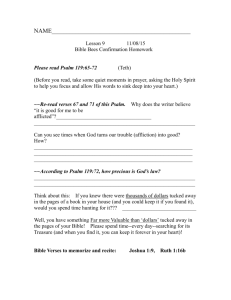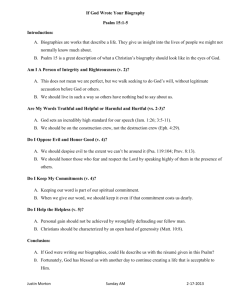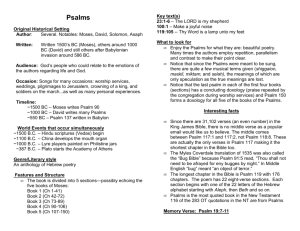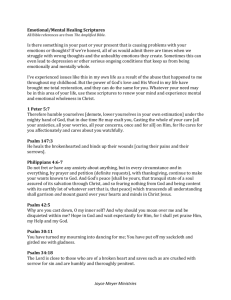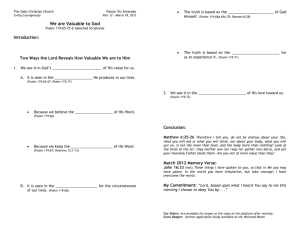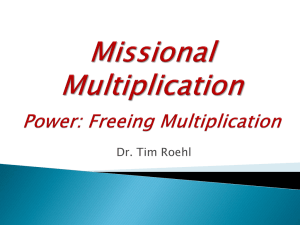No Fear! : Psalm 23 as a Careful, Conceptual Chiasm
advertisement
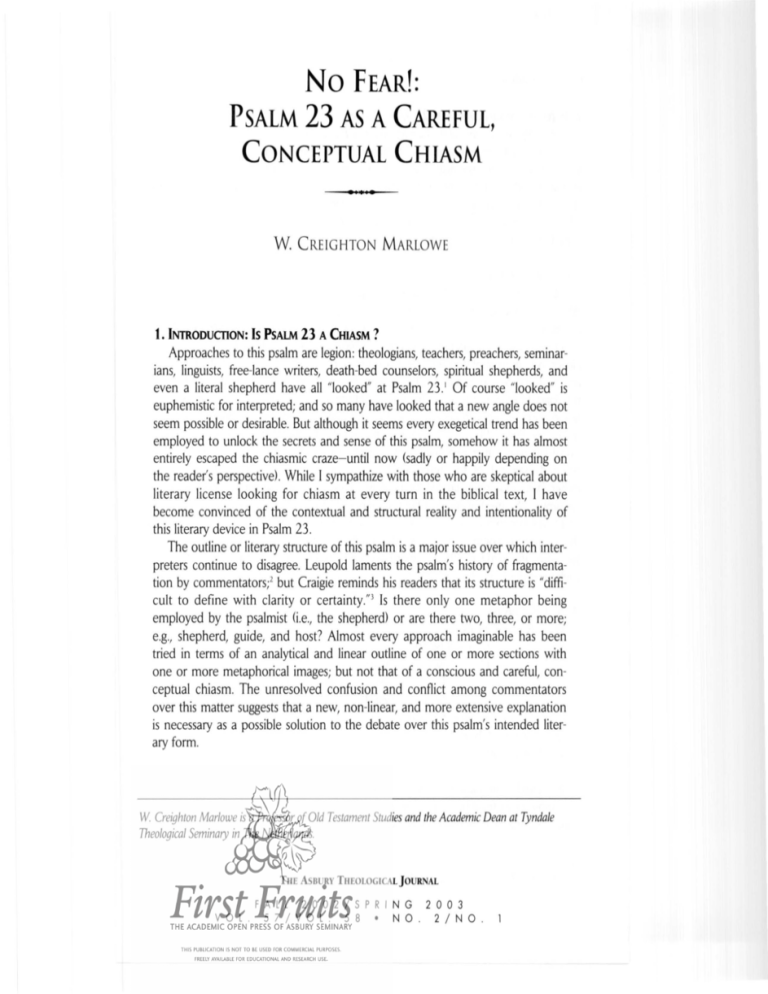
No FEAR!:
PSALM 23 AS A CAREFUL,
CONCEPTUAL CHIASM
•
I
•
W. CREIGHTON MARlOWE
1. INTRODu CTION: Is PSALM 23
A CHIASM ?
Approaches to this psalm are legion: theologians, teachers, preachers, seminarians, linguists, free-lance writers, death-bed counselors, spiritual shepherds, and
even a literal shepherd have all "looked" at Psalm 23. I Of course "looked" is
euphemistic for interpreted; and so many have looked that a new angle does not
seem possible or desirable. But although it seems every exegetical trend has been
employed to unlock the secrets and sense of this psalm, somehow it has almost
entirely escaped the chiasmic craze- until now (sadly or happily depending on
the reader's perspective). While I sympathize with those who are skeptical about
literary license looking for chiasm at every turn in the biblical text, I have
become convinced of the contextual and structural reality and intentionality of
this literary device in Psalm 23.
The outline or literary structure of this psalm is a major issue over which interpreters continue to disagree. Leupold laments the psalm's history of fragmentation by commentators/ but Craigie reminds his readers that its structure is "difficult to define with clarity or certainty."3 Is there only one metaphor being
employed by the psalmist (i.e., the shepherd) or are there two, three, or more;
e.g., shepherd, guide, and host? Almost every approach imaginable has been
tried in terms of an analytical and linear outline of one or more sections with
one or more metaphorical images; but not that of a conscious and careful, conceptual chiasm. The unresolved confusion and conflict among commentators
over this matter suggests that a new, non-linear, and more extensive explanation
is necessary as a possible solution to the debate over this psalm's intended literary form.
W. Creighton Marlowe is a Professor of Old Testament Studies and the Academic Dean at Tyndale
Theological Seminary in The Netherlands.
THE ASBURY THEOLOGI CAL J OURNAL
VOL .
FAll 2002 / SPRING
57 / VOl . 58
NO
2003
2 / NO
66
Marlowe
2.INTERPRfTATION OF PSALM 23 AS A CHIASM
2. , An Interpretive History of the Literary Structure Psalm 23
To date only general and topical chiastic outlines have been hinted at on rare occasions,' and a detailed metrical chiasm has been worked out;5 but not a detailed conceptual chiasm with a central, unrepeated climax as the solution to the debate over this psalm's
structure. These conceptually and structurally suggestive chiastic interpretations of Psalm
23 in its relatively recent and mostly scholarly literary history will be reviewed next, followed by the non-chiastic treatments.
2. ,. , Chiastic Considerations
Clarke's commentary (1976 edition) exhibits a chiasmus, although this pattern (A-B-BA) is not mentioned per se as characteristic of the literary structure: provision (vv. 1-3),
protection (v. 4), protection (v. 5), and provision (v. 6) .6 Y. Bazaq's 1981 stylistic and
structural analysis interpreted verse 4 as a center-point around which the rest of the psalm
circles. A pattern of phonological and conceptual parallels was observed between verses I
and 4, 2 and 5, and 3 and 6? The present proposal maintains the same verse (4) as the
theological fulcrum or thesis of the poem; but otherwise sees a chiastic pattern of similarities in purpose between verses 1-2 and 6 and 3 and 5. Gerstenberger hinted at a chiastic
nature for Psalm 23 in 1988 by saying that the final verse "returns to objective, confessional language," after explaining that it opens with a confessional.8 In 1990 L. F. Bliese
selected Psalms 1-24 for study, seeking to show that intentional structural symmetry
rather than randomness guided the psalmists. This author was satisfied that either metrical
chiasmus (28 times) or metrical homogeneity (12 times) is clearly present in these psalms
and should be expected in much of Old Testament poetry. In the former case (chiasmus)
the lines of the poem or of each stanza of a poem (working from the outside to the center) have the same number of word accents successively. For Psalm 23 the chiasmic
meter is 4655 6 5564:
A (v. I = 4 beats)
(v. 2 = 6 beats)
B
C
(v. 3 = 5 beats)
o
(v. 4a = 5 beats)
E
(v. 4b = 6 beats) = a marked peak
o
(v. Sa = 5 beats)
C
(v. 5b = 5 beats)
B
(v. 6a = 6 beats)
A (v. 6b = 4 beats).
The isolated central line or lines then become(s) its marked peak. In the latter instances
(i.e., those of metrical homogeneity) the accents per line are the same throughout a given
psalm, leading to a marked final (rather than centraD peak. 9
2. ,.2 Non-chiastic considerations
In 1982 R. Ahroni wrote on the unity of Psalm 23, arguing against what is viewed as
No Fear!
67
forced attempts to show unity through emendations; and seeking to establish an imaginative conceptual and emotional unity. In line with, but more specifically than Bazaq, 10
Ahroni identified verse 4b as the key thought around which the rest of the psalm
revolves: the "rod and staff' representing God's justice and mercy." R. S. Tomback reconsidered verse 2 the same year and used Mesopotamian backgrounds to explain this verse
in a manner consistent with the master (lord) and shepherd of verse I. While this study
was not concerned with the overall structural implications of this interpretation, the chiastic character of Psalm 23, which this current paper seeks to defend, depends on the close
association of verses 1-2 and their collective disassociation from verse 3-in contrast to the
modem tendencyl 2 to disregard the strong Masoretic disjunctive accent (rebia mugrash) of
verse I (while inconsistently following it in verse 3) and thus create a bi-cola with verse
2a, leading to the need to harmonize the text by producing another bi-cola from verses
2b and 3a and yet another from verse 3bY In 1985 an essay by C. O 'Connor on the
structure of Psalm 23 appeared, taking into account the metrical system developed by M.
O 'Connor. Results were: (J) sixteen lines: I bU linel, 2a-b[2 linesl, 3a-b[2 linesl, 4a-d[4
linesl, 5a-d3 linesl, and 6a-d[4 linesl; (2) two sections or stanzas of eight lines each: I b-4c
and 4d-6d; and (3) four strophes or paragraphs, each of related material, of four lines
each- two per stanza: I. I b-3a and 3b-4c, then II. 4d-5c and 6a-d.14 This still suggests a
hinge purpose for verse 4 but splits its contents between 4c and 4d, making the former
the close of section I and the latter the opening for section II. The verse is transitional as
demanded by a chiasm but the development of thought as viewed by O 'Connor is linear
rather than cyclical, since the verses of each strophe are seen as related, or intra-related,
but not inter-related with verses in other strophes. He offers few clues for a chiasm.
But chiastic or other similar structures in Hebrew poetry in general and in the Psalms
in particular (not Psalm 23 per se) were being noticed in the mid- I 980s. J. Bazak spoke of
concentric circles characterizing the shape of Psalm 25 and concluded, after an analysis of
Psalms 25, 34, 37, and 145, that similar shapes were either synonymous or chiastic.ls At
the same time J. S. Kselman put forth a chaistic interpretation of Psalm 10 I, one exegetical significance of which was to suggest that the question posed in verse 2b was answered
by verse 8.16 Then P. Auffret questioned the traditional assumption of great literary artistry
in Psalm 23 . Yet his study, while noting previously overlooked structural features, was
based on its traditional, linear two-part structure: verses 1-4 (part one) and verses 5-6
(part twO) .1 7 In the following year (1986) K. K. Sacon applied a literary-structural analysis
to Psalm I 13 and arrived at a chiastic colometry. 18 This supported the assumptions that
Bliese would make four years later. 19
Related to the relationship of verses 2 and 3, which issue has bearing on the chiasm
proposed in this paper, T. M. Willis in 1987, while not concerned with the outline or
structure of Psalm 23, argued grammatically for a thematic connection between verses 23a. These three cola describe three functions of a shepherd.20 The next year M. S. Smith
evaluated the traditional bi-partite outline of Psalm 23 and the attempts to reconcile the
seemingly conflicting images of God as first a shepherd (w. 1-4) and then as a host (w. 56). He concluded that unity is found only in the psalmist's perspective of a spiritual journey, wherein verses 1-4 present what a pilgrim would see on a journey to the temple and
verses 5-6 what happens at the end of his pilgrimageY In the same year Y. Mazor defend-
68
Marlowe
ed the traditional, gradual shift from shepherd to host (w. 4-5) as a compliment to another, earlier and sudden shift (vv. 3-4) from sheep (believer) to Shepherd (God).22 Mazor
claimed this results in an integrated, rhetorical unity that pictures God's grace through
twin images of "the stem protector and the generous host."2J By great contrast, also in
1988, D. P. McCarthy took a deconstructionist approach (a la Derrida), concluding that
Psalm 23 contains inherent contradictions that account for the interpretive confusion that
has characterized the scholarly study of these six verses to date. 24
In 1989 C. Gilead gave another approach to the standard double-stanza division of
Psalm 23. Each stanza was observed to contain three stichs and a conclusion, to be distinguished from the introduction and conclusion of the entire poem. Its literary and linguistic
substance and style were seen as a result of influence from the shepherd's hymn via the
contemporary Jeremiah. 25 The same year witnessed the publication of van Uchelen's 1989
article in which he sought to solve the problem of the diversity of interpretations of this
psalm's imagery and structure by looking for linguistic features that could provide empirical
evidence to point out the proper path to understanding the text. Structurally, however, he
still speaks of two different metaphorical halves.26 Noteworthy for the purposes of this present article is van Uchelen's conclusion that verse 4 (for grammatical reasons) provides the
key to the basic meaning of Psalm 23. This study's proposed chiasm centers on this verse
as the main and unparalleled point of the psalm as well. Finally in the most recent (1999)
return to Psalm 23 exegesis, Robinson adds little new for structural studies, presenting it as
a unity of two parts, vv. 1-3 then vv. 4-5. Verse six is deemed a conclusion. 27
2.2 An Interpretation of the Literary Category of Psalm 23
Psalm 23 should be viewed as an "Extended Confession of Trust," in form-critical
terms. 28 The Praise psalm flows in principle from the vow of praise, which is a typical feature of the classic and complete Lament psalm. In practice it comes from the reality of
release from ruin and its resulting resolve to recognize God's goodness and greatness
before others. Once saved the psalmist swears that public and vocal testimony will be
given as praise before the congregation. Likewise the standard petition section of a
Lament can lead to a single psalm devoted to prayer. So the confession of trust section
found in many or most laments gives rise to an externally but not existentially independent psalm, which (like the 23rd, for example) is categorically an extended Confession of
Trust in Yahweh as a certain savior and sustainer of life. This is a confession to Yahweh
that the psalmist still believes that He is his only true source of strength, sustenance, and
safety. Logically and functionally and necessarily this comes before the psalmist has experienced God's present promise and provision of victory, when it looks like defeat or death
is possible or even probable. Based on the consistent character of God and conduct and
commitments on behalf of the psalmist and other believers in the past, the psalmist determines to hang onto Yahweh as his only help, even if he fears the situation is hopeless.29
2.3 A Summary of the Debate over the Stnlcture of Psalm 23 and the Significance of a Solution
A major difference in interpretive approaches has been over how to explain the last
third of the psalm (vv. 5-6), where the poet shifts to imagery which seems to have nothing to do with shepherds and sheep, at least on the surface. Some, therefore, try logically
No Fear!
69
to explicate the visual changes from pastures (vv 1-3) to a dark or deadly predicament (v.
4) to being pampered before enemies and etemally protected (vv. 5-6). But others try to
show how the entire context of the psalm maintains a connection to the theme of sheep
and shepherd. Leupold's 1959 observation is still apt:
Then there is the matter of the unity of the psalm or the unity of the figure
employed by the psalmist Some, the majority, perhaps, find only one figure, that of
the shepherd. Of a slightly more recent date is the interpretation that finds two figures, that of the shepherd and that of the host. Others insert a third between the
two, the guide. Others, giving special thought to v. 6, devise some kind of a fourth
figure. By this time one is compelled to admit that the beautiful little psalm has
been pretty sadly fragmentized.30
A selective survey of commentaries from past to present will quickly reveal this confusion. Leupold (1959)- as one would gather from his comment above-takes a unified
shepherding approach which explains each part of the psalm as stating something the
Shepherd provides.31 VanGemeren in 1991 followed the typical bipartite shepherd-host
division (the Lord is my shepherd, vv. 1-4; and the Lord is my host, vv. 5-6).32 He also
notes three opposing works in regard to the subject of vv. 3-4: Thierry (1963) and Briggs
(1952), who see this passage as being about people, and Willis (1987), who relates it to the
three tasks of a shepherd for his sheep.33 Merrill (1965) and Eaton (1965) both give them
a royal meaning.J4 Briggs sees people being treated as guests in three ways: with God as
their shepherd (vv. 1-3a), guide (vv. 3b-4), and host (vv. 5-6).35 Clarke (1979) somewhat
artificially applies the shepherding metaphor throughout the psalm. He also forces the text
into ten available and alliterated resources for God's human sheep (which heightens the
dubious quality of his analysis); rest (v. 2), refreshment (v. 2). restoration (v. 3), regulation
(v. 3), rescue (v. 4), reassurance (v. 4), reception (v. 4), rejoicing (v. 5), retainers (v. 6), and
residence (v. 6).36 Craigie (1983) recognizes the two-fold shepherd-host arrangement as the
consensus; but observes at least two other valid metaphorical pattems: (I) the unity of the
shepherd motif throughout (a la Koehler) and (2) the lack of metaphor at all in vv. 5-6 (a
la Vogt, who takes these verses literally as a sacrificial banquet, which is also the psalm's setting).3? Kidner (1973), as well, accepts the double metaphors of first the shepherd and then
the friend. The shepherd by definition incorporates the functions of "guide, physician and
protector."38 In terms of Gattling criticism Gerstenberger gives the outline of this so-called
"song of confidence" in three parts, as (I) confessional statement, vv. 1-3; (2) affirmation of
confidence, vv. 4-5; and (3) expression of hope, v. 6. Against most modem analysts he
believes the psalm is structured according to liturgical needs.39
When Keller tumed in 1970 to his na·ive exposition of v. 5, his experience with watching shepherds compelled him to see the "table" which is being prepared by the shepherd
as the "tablelands" where sheep graze. Linguistically, therefore, Keller's basis for maintaining sheep as the subject of v. 5 is erroneous; even if the basic idea is correct. 40 Numerous
commentators, for similar or distinct reasons, are comfortable with the complete characterization of this psalm in shepherding imagery. Another example is Maddux's 1965
unversified outline, which is typical, as Keller, of the many popular and published, but
70
Marlowe
oversimplified, treatments of Psalm 23: the Shepherd's care; the Shepherd's redemption;
the Shepherd's presence; the Shepherd's protection; and the Shepherd's dwelling place.41
While some scholars also argue for the shepherding motif throughout Psalm 23, others
wonder how such imagery can reasonably be applied to sheep. As Kidner says parenthetically, 'The attempt to sustain the first metaphor [i.e., the shepherd] . . . would tum it
through a full circle, picturing men as sheep which are pictured as men-with their table,
cup and house-which is hardly a profitable exercise."42 As a final example, Alden (1974)
followed the shepherding theme consistently through the fourth verse, and then noted
there are multiple metaphors in verses 5-6. 43
If the present analysis is correct, the reason for the changes in imagery is to be
explained by the symmetric demands of the chiastic principles and parallels of the
ancient, eastern poetic mind and not by the dictates of western, analytic and systematic
thinking imposed on poetic literature, which has led to the false expectation of some type
of outline for the psalm in two parts (i.e., I. w. 1-4 and II. w . 5-6) and the need to try and
justify the transition from flock to feast.
2.4 The Chiastic Structure of Psalm 23 Exhibited
The charts that follow represent visually the conclusions reached in this examination of
Psalm 23 pertaining to its chiastic characteristics. It seemed best to allow the reader to
view the structure of the psalm suggested by this study, as a frame of reference, before
explaining the exegetical details used to support it.
2.4. 1 The Text of Psalm 23 as a Chiasm"
A
23: I Yahweh is my shepherd; [therefore] I shall not want.
23:2 He makes me lie down in green pastures; he leads me beside still waters.
S
23:3 He restores me: He leads me in right paths for his name's sake.
Even though I walk through the darkest valley,
a
C (23:4)
b
I fear no danger, for you are with me;
a
your rod and your staff- they comfort me.
S'
23:5 You prepare a table before me in the presence of my enemies;
you anoint my head with oil; my cup overflows.
A' 23:6 Surely goodness and mercy shall follow me all the days of my life, and I
shall dwell in the house of Yahweh my whole life long.
As an inclusio God's personal name, Yahweh, is used in the beginning and ending
verses. In terms of content both of these chiastic boundaries emphasize Cod's constant
and certain care. The Sovereign Shepherd of souls provides spiritually for His people
abundantly and appropriately.
2.4.2 The Themes of Psalm 23 as a Chiasm
When the previous chiastic scheme of the verses of Psalm 23 is translated into a thematic statement for each step of the chiasm, the following results :
No Fear!
A
A'
71
Complete provision (1 -2)
B
Purposeful Restoration (3)
a
Our need for rescue (4ai)
C (4) No need for fear: b
How to wait for rescue (4aii)
a'
His ability to rescue (4b)
B'
Purposeful Renewal (5)
Continual provision (6)
2.5 The Chiastic Significance of Psalm 23 Explained
2.5. 1 The Metrics of the Hebrew Text
The Masoretic major poetic disjunctive accents will be shown as used in Psalm 23 with
the MT. 45
: (silluq) ionK K7 II (rebia mugrash) 'l1i i11il' ( I b)46 A
: (silluq) 'J7i1J' mnJY.l 'Y.l711 (2b) II (athnach) 'JY':li' KIli, mKJ:l (2a)
II (athnach) :l:l,Ili' 'llibJ (3a) B
: (silluq) mlli 111Y.l7 II (rebia mugrash) p,y'7ll1Y.l:l 'JnJ' Ob)
II (pazer) nm7Y K'l:l17K""'I:J m (4ai)
(athnach) ',Y.l11 ilnK':J II (rebia magnum) l1iKi'K"k7 (4aii) C
: (silluq) 'JY.lnJ' ilY.lil II (rebia mugrash) 1nJl11lim 11.l:l1li (4b)
(athnach) 'iiY 'lJ II (rebia magnum) ln71li 'Jb71il1n (Sa) B'
: (silluq) il"i 't:l1:J II (rebia mugrash) 'IliKi lY.llli:l nJlli, (5b)
(athnach) "n 'Y.l,7:J II (dechl) 'J'b'i' ,on, :l'1.l1K (6a) A'
: (silluq) tJ'Y.l' 1iK7 II (rebia mugrash) i11il'-n':l:l 'n:llli, (6b)
Next the Masoretic major poetic disjunctive accents will be shown as used in Psalm 23
with an English translation :
A (J) Yahweh is my shepherd (rebia mugrash); II
I shall not want [for adequate carel (silluq) .
(2) He makes me lie down in green pastures (athnach) ; II
he leads me beside still waters (silluq) .
B (3) He restores me- (athnach); II
He leads me in the right paths (rebia mugrash), II
to protect His reputation (silluq).
ai If I might wander into the deepest,
darkest valley (pazer), I
C (4)
aii I fear no danger (rebia magnum); II
for you are with me (athnach) ; II
b Your rod and staff (rebia mugrash), I I
they comfort me (silluq) .
S' (5) You prepare a table before me (rebia magnum); II
in the presence of my enemies (athnach) . II
You anoint my head with oil (rebia mugrash); II
72
Marlowe
my cup overflows (silluq).
A' (6) Surely goodness and grace will follow me (dechl) I
all the days of my life (athnach) ;
and I will dwell in the house of Yahweh (rebia mugrash), II a long time (silluq).
As the above treatments of the text of Psalm 23 demonstrate, this present study rejects
the decision of some translators and textual emendators to "correct" the Masoretic Text
by re-arranging v. 3a as the final part of a tricolon along with v. 2a-b4 ? or as part of a
bicolon with 2b: 8 The latter makes an artificial division between 2a and 2b and forces v.
1 into the role of the initial parallel member of a bicolon comprising w. 1-2a 49 All these
approaches require the translator to disregard the punctuation of the Masoretic Text. In
this case the text makes good sense and probably the best sense if the MT versification
and accentuation are faithfully followed. This means, of the current and most popular
English versions, the NKJV50 presents and preserves the best organization and punctuation
of Psalm 23, in light of the premises and proofs of this paper.
Verse I (ignoring the superscription attributing the psalm to David; which is a later but
reliable editorial insertion) should be taken alone as a "synthetic"l! bicola and not as the first
colon of a bicola with verse 2a as the second, parallel member or line. The reasons are that
the MT employs: (I) most importantly, a strong disjunctive accent (rebia mugrash) above the
Hebrew word (riYiy) meaning "my shepherd," and (2) notably, the silluq with soph pasuq after
"want" ('e/:lS1r) indicating the end of the verse. In effect this verse briefly states the theme of
the psalm, and should be read with verse 2, which is the beginning of the chiastic poem per
se and corresponds to verse 6. Another altemative, better yet than separating 2a from 2b in
order to make v. I and 2a a bicola, would be to see w. 1-2 as a "tricola" (monocolon plus
bi-cola). This alternative approach still, however, has to ignore the strong disjunctive in v. 1
to make it a monocolon; so the most consistent treatment is to take w. I and 2 together as
two lines of bicola, which provide the first level of the chiasm, linking a short thematic preface (v. I) with the initial thought of the following five verses. This finds its counterpart in v.
6, which is rather lengthy anyway, as a balance to w. 1-2, and ends with thoughts of "ever
dwelling" (v. 6b) as a fitting mirror image of "never wanting" (v. I bl. Either way w. 1-2 comprise the first chiastic level.
Whether verse I is a monocolon or bicola, the parallelism of verse 2 should be retained
as a bicola ending with the silluq of that verse, as in the MT, and not restructured to include
3a to produce either a bicola of v. 2b with v. 3a or a tricola of w . 2a-3a. A very strong disjunctive accent (athnach) divides verse 2 into a pleasing and productive bicola: "He makes
me lie down in green pasturesllHe leads me beside still waters," followed by the sign ending
a verse. While MT versification is not automatically absolute, the text makes good sense as it
stands, probably the best sense as this discussion will defend. The seeming bases for altering
the sense of the MT here are the assumptions of a necessity: (I) to parallel w. 3a with 2b
(because of the arbitrary decision to parallel w. 1 and 2a) and/or (2) to parallel v. 3a with
verse 2 because of a shared theme and since 3b can stand alone, theoretically, as a "synthetic"52 bicola. However, as will be developed below, the meaning of v. 3a fits as well if not better with the rest of verse 3 as with verse 2. Verse 3a is separated from 3b by another athnach and then 3b itself has two parts created by the strong but less strong rebia-the same
No Fear!
73
but only accent of verse I b, following the non-original superscription in I a. Therefore verse
2 should be identified as a synonymous bi-cola and verse 3 with its major dichotomy after
3a as: (I) probably, a tricola composed of a monocolon (v. 3a) followed by a "synthetic"
bicola (v. 3b); or (2) possibly, as a synonymous or synthetic bicola. These options for verse 3
compare and contrast as follows :
He restores me:!/
He leads me in right paths,!
for His name's sake.
(or
He restores me [in righteousness, for the sake of His reputationl;!/
He leads me in right paths, for His name's sake).
As already noted, a chiasm based on the meter of Psalm 23 has been proposed by
Bliese: A:4, B:6, C:5, 0:5, E:6, 0 ':5, C:5, B':6, A':4. This scheme of nine elements was
based on a verse distinction of, respectively, verses I, 2, 3, 4a, 4b, Sa, 5b, 6a, and 6b. The
present study recognizes a different versification for the thematic chiasm: 1-2, 3, 4, 5, 6 but
still finds the same center. Based on this latter scheme and on one beat per word (counting
words joined with maqqeph as one beat:), the parallelism and meter of Psalm 23 may be analyzed as follows: A: I 0, B:6, C: 12, B': I 0, A': I O.
Verse
Parallelism
Meter
A (Ib)
"synthetic" bicola
2 :2
(2a-b) synonymous bicola
3:3
(3a)
B
monocolon
"synthetic" bicola
(3b)
[or 3a-b
"synthetic" bicola
(4ai)
C
monocolon
(4aii-b) "synthetic" bicola
(Sa)
B'
"synthetic" bicola
(5b)
"synthetic" bicola
A' (6a)
"synthetic" bicola
(6b)
"synthetic" bicola
Total Beats
10
2:
2 :2
2:41
4:4
3:2
3:2
4:2
2 :2
06
4:
12
10
10
If the parallelism is split as bicola at athnach only, a clear A-B-CB'-A' chiastic pattern
also emerges for this psalm, with verse 4 having a unique meter and, therefore, consciously constructed as the center of the psalm :
Section
Verse(s)
Metric Pattern
A
B
C
B'
1-2
3
4
4 :6
2:4
8:4
10
06
5
5:5
A'
6
6:4
10
10
Total Beats
12
74
Marlowe
As seen v. 3 may be analyzed as either a monocolon with a synthetic bi-coloa or as a
synthetic bi-coloa in which the first line (3a, extant as only a monocolon) assumes a similar or related section of line 2 (3b) following "He leads me" for completion of its thought.
"He leads me" of line two would be parallel with "He restores me" of line one. If intended
as identical or very similar sentiments then this verse of poetry could be seen as synonymous rather than "synthetic." Either way-as synonymous or synthetic, or two, three, or
four stanzas of poetry- if the first line (v. 3a) is a shortened corruption or creation based
on an originally intended longer version (echoing or enhancing 3b), then the metrics
would come out closer to 8 or 10 beats, rather than 6, which would more closely parallel
the 10 beats of verse 5, its chiastic counterpart. In addition the metric pattems 4:6 in the
opening vv. 1-2 and 6:4 in closing v. 6 provide an inclusion for the chiastic poem and
together make a 6-4-4-6 chiasm.
For an altemative approach, if one combines 4ai with v. 3 the outcome is 10 beats,
leaving 8 beats for 4aii-b as the center or peak, and creating a perfectly balanced a-b-c-b'a' metrical chiasm of 10-10-8-10-10 beats (vv. 1-2, 3-4ai, 4aii-b, 5, 6). This outcome is
pleasant but it flies in the face of the weak pazer accent at the end of 4ai, treating it as a
strong disjunctive. But if the MT accents are viewed as usually reliable while not absolute
guides, then in this scenario, the result is a much longer B element (vv. 3-4ail which
would be seen as a monocolon of 2 beats (v. 3a) followed by a bicola of 4:4 beats (vv.
3b-4ail. The C unit (v. 4aii-b) or apex would be a bicola of 4:4 beats (or altematively two
bicola of 2:2 and 2:2 beats) which fits together well, perhaps synonymously: "I fear no
danger for you are [your protection is) with me! // [I fear no trouble forl your rod and
your staff comfort me!" Verse 4ai also goes well with the preceding verse 3 : "He restores
me: / / He leads me in the right paths to protect His reputation / / in case) might wander
into a deep, dark valley." When in this scheme 4aii-b is taken as the center section, as
with the previous proposal, it also reflects a micro chiasm within the macro chiasm of the
entire psalm, although in this case a-b-b'-a' (instead of a-b-a'). Still the main idea includes
Cod's presence which excludes all fear:
A
B
B'
A'
I fear no danger (rebia magnum)
for you are with me (athnach)
your rod and your staff (rebia mugrash)
they comfort me (silluq).
2 beats
2
2
2
No chiasm of the parallelism in Psalm 23 is observable. The first chart above of the
metrical chiasm has the advantage of showing the three parts of v.4, which themselves
can be seen to present an a-b-a' chiasm of 4-4-4 beats. There is in addition another way
to view verse 4, the fulcrum section of this poem. Verse 4aii, which has been presented
as the central theme around which the psalm rotates and the central phrase around
which this verse revolves (making a chiastic verse within a chiastic psalm), also demonstrates its centrality in another fashion.
The first phrase of this sentence (") fear no danger"; v. 4aii-cd fits well with the preceding and initial clause of this verse (4ail, while the second phase ("for you are with me"; v.
4aii-p) fits with the following and concluding clause/ sentence (v. 4bl. This highlights v. 4aii
No Fear!
75
as the point around which the other parts of v. 4 rotate and from which they depart. In
4aii, the first phrase, "I fear no danger," is in line with the preceding statement and pronoun "even though I might wander into a deep, dark valley." And, although followed by
the athnach (a disjunctive pointing back), the second phrase of v. 4aii, "for you are with
me," is in keeping with the following sentiment and pronoun "your rod and staff, they
comfort me." Perhaps this is why the rebia magnum is used with the former phrase and
the athnach with the latter. The athnach marks the end of a complete thought, yet the last
part of that thought ("for you are with me") has to do double duty for what is before and
after. Therefore 4aii-a has a strong pause before moving on to 4aii-~. And together these
two phrases provide the fulcrum and foundational theme of Psalm 23 : "I fear no danger;
for you are with me!" Psalm 23 calls the reader to a fearless life, and uses a creative and
carefully constructed chiasm to do it conceptually, metrically, and dramatically.
2.5.2 The Mechanics and Meaning of the Hebrew Text
Level A, A' (Outer): (w. 1-2; II v. 6)
Yahweh Shepherds with Complete and Continual Provision
Verse la-b: "Yahweh is my shepherd; II
I will lack nothing [essential spirituallyl."
Verse 2a-b: "He causes me to lie down in green pastures; II
He leads me [to lie down] beside quiet water."
Verse 6a-b: "Undoubtedly goodness and grace will accompany me
every day of my life; II
and I will return to [or "dwell in"] the house of Yahweh a long time."
Level B, B' (Inner) : (v. 3 II v. 5)
Yahweh Shepherds with Purposeful Renewal and Restoration
Verse 3a-b: "He restores me [physically and spiritually]; II
He leads me along the right paths, I
For the sake of His own reputation."
Verse Sa-b: "You prepare a table before me in the presence of my enemies; II
You anoint my head with oil,!
My cup overflows."
Level C (Center) : Climax: (v. 4)
Never Fear!
Level C, -a, -a' (Outer Climax) : (v. 4a, b)
The Sheep's Need and the Shepherd's Nature for Rescue
All-Present, regardless of the environment (v. 4ai)
Verse 4a: "Yes, even though 1 might wander through a
valley of deep darkness," I
All-Powerful, regardless of the enemy (v. 4b)
Verse 4c: "Your rod and staff, they comfort me."
Level C, -b (Inner Climax) : (v. 4aiil
No Need for Fear! The Divine Shepherd is Always Near
Verse 4b: "I will not be afraid of any danger, for You are with me!"
76
Marlowe
3. CONCLUSION: PSALM 23 Is A CHIASM!
Psalm 23 has a chiasm within a chiasm. Its formation is both simple and sublime. The
entire psalm exhibits an A-B-C-B'-A' chiastic pattern, with the climactic and center section/verse (C; v. 4) also displaying a sub-chiasm, having the pattern of a-b-a' (or a-b-b'-a').
In this way the psalm means to help the reader make no mistake by making it abundantly
clear: Yahweh's presence prevents all panic. The outer layer of corresponding verses is
composed of the cluster of w. 1-2 which parallels v. 6. The inner layer of correspondence
juxtaposes v. 3 with v. 5. Finally the focus falls on v. 4, wherein the psalmist's fearless
proclamation in the light of Cod's presence in the midst of deep darkness is framed by
reflections on his perilous situation and Cod's powers of salvation.
SELECTED BIBUOGRAPHY ON THE STRUCTURE OF PSALM
23
Ahroni, Reuben. 'The Unity of Psalm 23," Hebrew Annual Review 6 (\ 982): 2 1-34.
Alden, Robert L. Psalms of Devotion. Vol. I: Psalms I-50. Chicago: Moody Press, 1974.
Auffret, Pierre. "Essai sur la structure litteraire du Psaume 23," £Studios Biblicos 43 (1985): 557-88.
Bazak, Jacob. "Structural Geometric Patterns in Biblical Poetry," Poetics Today 6 (\ 985): 475-502.
Bazaq, Y. "Psalm 23 (The Lord Is My Shepherd')-As a Patterned Poem," Beth Mikra
2
6
(\98D: 370-77 [Hebrewl.
Bliese, Loren F. "Structurally Marked Peak in Psalms 1-24," Occasional Papers in Translation and
Textlinguistics 4:4 (\ 990): 265-32.
Clarke, Arthur G. Analytical Studies in the Psalms. Grand Rapids: Kregel Publications, 1979; reprint of
1976 3rd edition.
Craigie, Peter C. Psalms I-50, p. 204, in Word Biblical Commentary. Vol. 19, ed. John D. W. Watts.
Waco, Texas: Word Books, 1983 .
Eaton, John. "Problems of Translation Psalm 23:3(" [sicJ Bible Translator 16 (\ 965): 17 1-76.
Gerstenberger, Erhard S. Psalms, Part I with an Introduction to CuItic Poetry. The Forms of Old
Testament Literature. Vol. 14. Grand Rapids: Wm. B. Eerdmans Publishing Co., 1988.
Gilead, Chaim. "Psalm 23 in View of Biblical Realia," Beth Mihra 35 (1989-90): 341 -47
[Hebrewl.
Kidner, Derek. Psalms / -72. Downers Grove, IL.: Inter-Varsity Press, 1973.
Koehler, L. "Psalm 23," Zeitschrift fiir die alttestamentliche Wissenschaft 68 (\ 956): 227-34.
Kselman, John S. "Psalm 101 : Royal Confession and Divine Oracle," Journal for the Study of the Old
Testament 33 (\ 985): 45-62.
Leupold, H. C. Exposition of the Psalms. Grand Rapids: Baker Book House, 1959; 1969 reprint.
Lundbom, Jack R. "Psalm 23: Song of Passage." Interpretation 40 (1986): 6-16.
Maddux, Roy Clark. The Psalms in Outline. Grand Rapids: Baker Book House, 1965.
Mazor, Yair. "Psalm 23: The Lord is My Shepherd- Or is He My Host?," Zeitshcrift fiir
die alttestamentliche Wissenschaft 100 (1988): 416-20.
McCarthy, David Paul. "A Not-50-Bad Derridean Approach to Psalm 23," Proceedings,
E a s t ern
Great Lakes and Midwest Biblical Societies 8 (1988): 177-92.
Merrill, A. L. "Psalm XXIII and the Jerusalem Tradition," Vetus Testamentum 15
( 1965):354-60.
Mittmann, Siegfried. "Aufbau und Einheit des DankJieds Psalm 23," Zeitschrift fiir
Theologie
und Kirche 77 (\ 980) : 1-23.
O 'Connor, Charles. "The Structure of Psalm 23," Louvain Studies 10 (1985) : 206-30.
Robinson, Bernard P. "Pastures New: The 23rd Psalm Revisited," Scripture Bulletin 29 (1999): 2-10.
Sacon, K. K. "A Methodological Remark on Exegesis and Preaching of Psalm I 13," Nihon no
Shingaku 25 (\ 986) : 26-42 [Japanesel.
No Fear!
77
Smith, Mark S. "Setting and Rhetoric in Psalm 23," Journal for the Study of the Old Testam ent
41
(\ 988) : 61 -66.
Stenger, Werner. "Strukturale 'relecture' von Ps 23," Freude an der Weis"ung des Herrn,
Beitriige zur Theologie der Psalmen, Festgabe zum 70. Geburtstag von Heinrich Gross, edd. Ernst Haag
and Frank-Lothar Hossfeld. Stuttgart: Katholisches Bibelwerk, 1986.
Uchelen, N. A. van. "Psalm XXIII : Some Regulative Linguistic Evidence," Old Testament Studies 25
(\ 989) : 156-62.
VanGemeren, WiUem A.. "Psalms," pp. 214-17 in The Expositor's Bible Commentary, ed. Frank. E.
Gaebelein, et al. Grand Rapids: Zondervan, 1991.
Vincent, Jean Marcel. "Recherches exegetiques sur Ie Psaume xxiii," Vetus Testamentum 28 (\ 978):
442-54.
Vogt, E. ''The 'Place in Life' of Ps. 23," Biblia 34 (1953) : 195-211.
Wendland, Ernst R. Analyzing the Psalms. Dallas, TX: Summer Institute of Linguistics, 1998.
Willis, Timothy M. "A Fresh Look at Psalm xxiii 3a," Vetus Testamentum 37 (\987) : 104-106.
NOTES
I. Cf. Phillip Keller, A Shepherd Looks at Psalm 23 (Grand Rapids : Zondervan Publishing
House, I 970l. Keller grew up in East Africa surrounded by herdsmen and also spent eight years as
a sheep owner and rancher (n.p.; from the "Introduction").
2
H. C. Leupold, Exposition of the Psalms (Grand Rapids: Baker Book House, 1959; 1969
reprint), p. 208.
3. Peter C. Craigie, Psalms I -50, p. 204, in Word Biblical Commentary, vol. 19, ed. John D. W.
Watts (Waco, Texas : Word Books, 1983).
4. See comments on Clarke's commentary below and in n. 6.
5. See p. 3 and note 9 below.
6. See Arthur G. Clarke, Analytical Studies in the Psalms (Grand Rapids : Kregel Publications,
1979 reprint of 1976 3rd edition), pp. 78-79.
7. Cf. Y. Bazaq, "Psalm 23 ('The Lord is My Shepherd')- As a Pattemed Poem," Beth Mikra 26
(1981): 370-77 [Hebrew) and a review of the same by Frederick E. Greensphan in Old Testament
Abstracts [hereafterOTAl 5:2 (june 1982): 161 (*53 7).
8. Erhard S. Gerstenberger, Psalms, Part I with an Introduction to Cultic Poetry, The Forms of Old
Testament uterature, vol. 14 (Grand Rapids: Wm. B. Eerdmans Publishing Co., 1988), pp. 114-115.
9. Cf. Loren F. Bliese, "Structurally Marked Peak in Psalms 1-24," Occasional Papers in
Translation and Textlinguistics 4:4 ([990) : 265-321 , and a review of the same by Deirdre A.
Dempsey in OTA 15:3 (October 1992) : 396-97 (* 143 Il.
10. See p. 2 and n. 7 above.
I I. Cf. Reuben Ahroni, ''The Unity of Psalm 23," Hebrew Annual Review 6 (\ 982) : 21 -34 and a
review of the same by William J. Urbrock, OTA 11 :2 (june 1988): 165-66 (*597).
12. Cf. both recent translations like the NN and NRSV and the edited page of BHS.
13. Since v. 3b contains the same strong disjunctive as v. I, this is possible. But another and
better altemative is to see 3b as a bi-cola following and fitting with the monocolon 3a to create a
type of synthetic "tricola."
14. Cf. Charles O'Connor, ''The Structure of Psalm 23," Louvain Studies 10 (\ 985): 206-30,
and a review of the same by Charles H. Miller in OTA 9:2 (june 1986): 185 (*528).
15. Cf. Jacob Bazak, "Structural Geometric Pattems in Biblical Poetry," Poetics Today 6 (1985) :
475-502, and a review of the same by M. F. Collins in OTA 9:2 (june 1986): 185-86 (*529).
16. 0 . lohn S. Kselman, "Psalm 101: Royal Confession and Divine Oracle," Journal for the Study
of the Old Testament 33 (I 985): 45-62, and a review of the same by John M. Halligan in OTA 9:2
(june 1986) : 187 (*534).
78
Marlowe
17. Cf. Pierre Auffret, "Essai sur la structure litt(~raire du Psaume 23," £Studios Biblicos 43 (1985):
557-88, and a review ofthe same by Hector Avalos in OTA 9J (October 1986): 288 (*817).
18. Cf. K. K. Sacon, "A Methodological Remark on Exegesis and Preaching of Psalm 113,"
Nihon no Shingaku 25 (1986): 26-42 [Japanesel, and a review of the same by the author in OTA
10: I (February 1987): 64 (*22 J).
19. See p. 3 and n. 9 above.
20. 0 . Timothy M. Willis, "A Fresh Look at Psalm xxiii 3a," Vetus Testamentum 37 (1987):
104-106, and a review of the same by the author in OTA 10J (October 1987): 270 (*824).
21 . Cf. Mark S. Smith, "Setting and Rhetoric in Psalm 23," Joumal for the Study of the Old
Testament 41 (1988): 61 -66, and a review of the same by John M. Halligan in OTA 12: I (February
1989): 67 (*228) .
22. Cf. Yair Mazor, "Psalm 23: The Lord is My Shepherd- Or is He My Host?," Zeitschrift fiir die
alttestamentliche Wissenschaft 100 (1988) : 416-20, and a review of the same by John W. Wright in
OTA 14:2 (june 199J): 184 (*633).
23. Cf. ibid., p. 420 and p. 184.
24. 0 . David Paul McCarthy, "A Not-So-Bad Derridean Approach to Psalm 23," Proceedings,
Eastern Great Lakes and Midwest Biblical Societies 8 (1988): 177-92, and a review of the same by
Mary K. Deeley in OTA 14:2 (june 199 J): 184-85 (#634) .
25 . 0 . Chaim Gilead, "Psalm 23 in View of Biblical Realia," Beth Mihra 35 (1989-90): 341 -47
[Hebrewl, and a review of the same by Frederick E. Greensphan in OTA 14:2 (june 199J): 184
(*632).
26. Cf. N. A. van Uchelen, "Psalm XXIII: Some Regulative Linguistic Evidence," Old Testament
Studies 25 (1989): 156-62, and a review of the same by Wayne Pitard in OTA 13:2 (june 1990) :
170-71 (*563).
27. Cf. Bemard P. Robinson, "Pastures New: The 23rd Psalm Revisited," Scripture BuJ/etin 29
(1999) : 2-10, and a review of the same by Paul L. Redditt in OTA 22J (October 1999) : 461 -462
(*1618).
28. Cf. Gerstenberger, Psalms, pp. 113-116. Robinson calls it a "Psalm of Confidence." See
Redditt, p. 461 .
29. Cf. Psalm 3 :1 -3 and 13:1 -5, where, respectively, v. 3 and v. 5 are the confessions of trust.
30. Leupold, Exposition of the Psalms, p. 208.
31. 0 . Leupold, p. 209. Leupold's outline is that the Shepherd provides rest and guidance (w.
2-3); protection (v. 4); food (v. 5); and fellowship (v. 6b). Y. 6a is viewed as a parenthesis wherein
the psalmist abandons any figure of shepherding.
32. 0. Willem A. VanGemeren, "Psalms," pp. 214-17 in The Expositor's Bible Commentary, ed.
Frank. E. Gaebelein, et a!. (Grand Rapids: Zondervan, 1991) . He calls the poem's structure both
simple and complex, but his analysis reveals only the former description. He references several
German and one French articles and some English articles and one book on the structure and
metaphors of Psalm 23 - which are probably the source of his comment on the psalm's complexity- but he does not remark on any chiastic interpretations found therein. Sources on structure he
mentions are, Craigie, Psalms I-50, pp. 204-205; Charles O'Connor, "The Structure of Psalm 23:
Louvain Studies 10 (1985) : 206-30; Siegfried Mittmann, "Aufbau und Einheit des Danklieds Psalm
23," Zeitschrift fiir Theologie und Kirche 77 (1980): 1-23; Wemer Stenger, "Strukturale 'relecture' von
Ps 23 ," Freude an der Weisung des Herm, Beitriige zur Theologie der Psalm en, Festgabe zum 70 .
Geburtstag von Heinrich Gross, ed. Ernst Haag and Frank-Lothar Hossfeld (Stuttgart: Katholisches
Bibelwerk, 1986), pp. 441 -55; and Jean Marcel Vincent, "Recherches ex~getiques sur Ie Psaume
xxiii," Vetus Testamentum 28 (1978): 442-54.
33 . Cf. VanGemeren, Psalms, p. 217, notes; citing G. J. Thierry, "Remarks on Various Passages
in the Psalms," Oud Testamentische Studien 13 (1963) : 97, C. A. and E. G. Briggs, The Book of Psalms,
No Fear!
79
vol. I (Edinburgh: T. & T. Clark, 1952 impression), p. 207; and Timothy A. Willis, "A Fresh Look at
Psalm xxiii 3a," Vetus Testamentum 37 ([ 987): 104-106.
34. Cf. VanGemeren, p. 217, citing A. L. Merrill, "Psalm XX111 and the Jerusalem Tradition,"
Vetus Testamentum 15 ([965): 354-60 and John Eaton, "Problems of Translation Psalm 23:3f," [sid
Bible Translator 16 ([ 965): 171 -76. In this regard one should also see John Eaton, Kingship and the
Psalms, (SBT, Second Series 32. London: SCM Press, 1976), pp. 36-38.
35. Briggs, The Book of Psalms, p. 207.
36. Clarke, Analytical Studies, pp. 78-80.
37. Craigie, Psalms I-50, pp. 204-205, citing E. Vogt, 'The 'Place in Life' of Ps. 23," Biblia 34
(1953): 195-211 and L. Koehler, "Psalm 23," Zeitschrift fiir die alttestamentliche Wissenschaft 68
(1956): 227-34.
38. Derek Kidner, Psalms 1-72 (Downers Grove, IL.: Inter-Varsity Press, 1973), pp. 110-1 I 1_
39. Gerstenberger, Psalms, Part I with an Introduction to Cultic Poetry, pp. I 13, I 15.
40. Cf. Phillip Keller, A Shepherd Looks at Psalm 23, pp. 104- 105. He points out how the
Spanish word mesa (a high plateau where sheep graze) means "table"; and the same word with the
same meaning appears in an African dialect. Of course it only matters if this is the meaning of the
Hebrew word David used, llJ~\1J. But this O ld Testament Hebrew term appears only to be used of
an ancient "table" where humans eat: either of a leather mat placed on the ground (cf. Isa. 21 :5), a
(usually royal) table with dishes (cf. I Kings 5:7), or of a cultic table for sacrificial food or meat (cf.
Exod. 25:23; Ezek. 40:39f.l. See the standard Hebrew lexica.
41. Roy Clark Maddux, The Psalms in Outline (Grand Rapids: Baker Book House, 1965), p. 19.
42. Kidner, Psalms 1-72, p. III.
43. Robert L. Alden, Psalms of Devotion, vol. I: Psalms' -50 (Chicago: Moody Press, 1974), p. 59.
44. The adapted translation used as a convenience for this chart is that of the NRSV. The punctuation and some wording have been changed to fit the conclusions of this paper. The differences
are that NRSV has (I) a comma after "shepherd" in v. I; (2) a semi-colon after "waters" in v. 2; (3)
a period after "my soul" in v. 3, which is here translated "me"; (4) a semicolon after "evil" in v. 4,
which is here rendered "danger"; and (5) the traditional substitution of LORD for the appearance in
the Hebrew text of the tetragrammaton (hwhy), for which Yahweh (the standard pronunciation)
has been re-substituted. Also any words in brackets are supplied. The Hebrew word often taken as
"soul" (vpn) when used with a suffixed personal pronoun, usually refers to that person's own life or
self; therefore, the pronoun itself has the same sense in English. In such cases "soul" has nothing to
do with an immaterial part of a person that lives on after death. It does refer to the life force of a
person in the sense of his own life or self; and consequently the NRSV as other modem versions
sometime do, gives a footnote for the use of "soul" in the text of this psalm which says "or life" or
something similar.
45. Listed in descending priority, these accents are: I. Silluq; 2. Oley Veyored; 3. Athnach; 4.
Rebia Magnum; 5. Rebia Mugrash; 6. Shalsheleth Magnum; 7. Sinnor; 8. Rebia Parvum; 9. Dechi vel
Tiphcha; 10. Pazer; I I. Mehuppak; 12. Azla.
46. Ia of the MT is the editorial superscription added to the "original" psalm.
47. Cf. NRSV and NIV.
48. Cf. BHS.
49. Cf. Wendland's linguistic analysis of Psalm 23 in Ernst R. Wendland, Analyzing the Psalms
(Dallas, TX: Summer Institute of Linguistics, 1998), p. 66. Wendland notes how many or most
translations into English do not reflect the strict formal correspondence that exists between the parallel lines of this verse in Hebrew: In-pastures-of greenness he-Iays-me-down / / Beside-waters-of
quietness he-leads-me.
50. The KJV has the same versification, naturally, and similar punctuation; but the NKJV is
superior translationally (in terms of structure and poetic sensitivity) because it presents the poetic
80
Marlowe
and musical nature-which is intrinsic to all members of the Hebrew psalter- through the use of
poetic stanzas. The psalms are songs and the Old Testament Psalter (Book of Psalms) was the
hymnbook of ancient Israel. All psalms are poetry that was eventually set to music for use in the
worship that occurred in the Temple in Jerusalem and, later, the synagogues. On the other hand,
the NKjV, also like the KJV, does not necessarily have the best rendering for all words and phrases
in this psalm; more modem versions like the NRSV and NIV win in this category.
51 . This term can be meant generally (as here) for any parallelism besides those that are synonymous or antithetical; or it can relate specifically to a category of parallelism when more than
three types are assumed.
52. See nn. 13 and 51 above.
